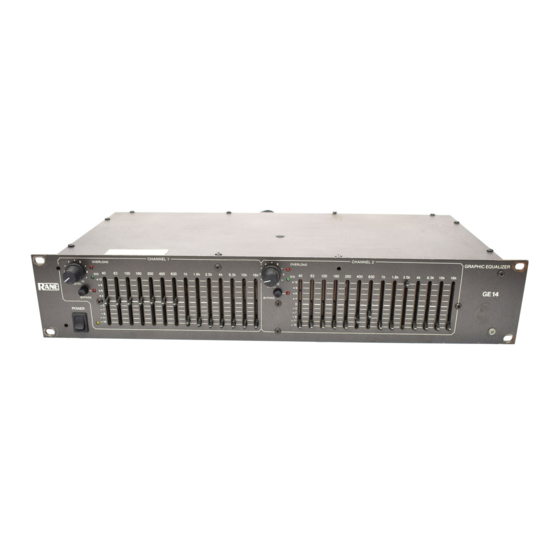
Advertisement
Quick Links
QUICK START
The GE 27 and GE 14 are extremely accurate instruments capable of precise equalization down to a fraction of a dB.
However, equalizing a sound system by ear is very difficult to do with any degree of accuracy, even with years of
training.
To obtain the best performance from your equalizer it is strongly recommended that you use some type of realtime
analyzer. Any equalizer used in conjunction with a well designed analyzer system will be significantly more effective in
reducing feedback and providing consistent, optimum sound quality in varying acoustical environments.
If you don't have an analyzer (such as the Rane RA 27), then you will have to resort to Section 2408, paragraph 84-B
of the Performing Musicians Code, which reads:
"Fiddle with it until it sounds good."
This fiddling process can be both time-consuming and frustrating with a 1/3 or 2/3 octave equalizer––you can end up
chasing your own tail until all the sliders wind up at full boost, unless you have a basic procedure to follow. If you
haven't one of your own, here's a procedure you might try.
Point to remember: All things are relative. This applies especially well to tonal perception. What sounds like too little
bass could really be too much midrange, and so on.
The idea is to start with some frequency area and use it as a reference for further comparison; then leave this area
pretty much alone and make your adjustments elsewhere. Otherwise you might wind up hopelessly trapped in Murphy's
EQ Syndrome, which roughly reads:
"O.K., we need more low end here; now add a little presence at 10k or so; hmmm, mid range is off a little, so I'll
bump up 800 and 1k; now I need more punch, so up with 80, 100 and 125; darn, presence is still not there, so more of the
5k and 6.3k, vocals seem a little buried—needs more 1.25k and 1k..." and so on until all the sliders are near full boost
and you have a high-dollar volume control.
To avoid this, choose an area in which you know your speakers perform well, such as around 1kHz. Leave this area at
roughly center position on the sliders and then compare bass, mid bass, mid highs and highs to the 1kHz area. Then if, for
example, the overall sound appears to be "boomy", muddy, or lacking in midrange, turn down the mid bass and/or mid
highs––don't turn up the 1kHz midrange area instead, or you'll be headed right into the vicious circle.
Once you are familiar with your own system, you will develop your own procedure. The golden rule is:
"Whatever Works, Works."
OPERATING / SERVICE MANUAL GE 14/GE 27
GRAPHIC EQUALIZERS
Advertisement

Summary of Contents for Rane GE 14
-
Page 1: Quick Start
If you don’t have an analyzer (such as the Rane RA 27), then you will have to resort to Section 2408, paragraph 84-B of the Performing Musicians Code, which reads: “Fiddle with it until it sounds good.”... -
Page 2: Front Panel Description
FRONT PANEL DESCRIPTION 1. POWER Switch: It comes as no surprise that this switch turns the GE 27/GE 14 on and off. An LED is located to the right of this switch that illuminates when the unit is turned on. Each output of the GE 27/GE 14 is fitted with a relay which provides delayed turn-on and instant turn-off to avoid switching transients. -
Page 3: Rear Panel Description
Input signals. For unbalanced operation, use a mono (single-conductor) shielded ¼" patch cord. For balanced operation, use a two-conductor shielded cable wired to a stereo TRS ¼" male plug as in Rane Note 110 (supplied with this unit). 2. OUTPUT Jack: This is a ¼" TRS (Tip-Ring-Sleeve) jack which delivers an unbalanced Output signal. Tip is “+” or “hot”, ring is signal ground, and the sleeve is not connected. - Page 4 If the output of the mixer is unbalanced, use a shielded mono switch in the “grounded” position, tying circuit ground to ¼" patch cord to the GE 27 or GE 14 Input(s). If the mixer is chassis ground. If after hooking up your system it...







